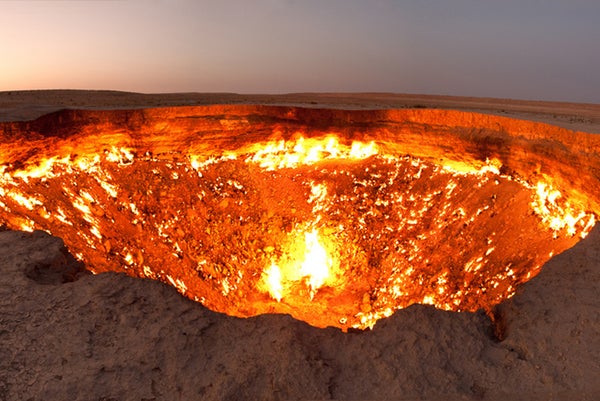This article was published in Scientific American’s former blog network and reflects the views of the author, not necessarily those of Scientific American
Happy Halloween, my darlings! In honor of the spookiest holiday, I've amassed a collection of the eeriest, most outrageous, and supremely astonishing geology on Earth.
Screaming Volcanoes
What could be more appropriate for Halloween than a volcano that screams?
On supporting science journalism
If you're enjoying this article, consider supporting our award-winning journalism by subscribing. By purchasing a subscription you are helping to ensure the future of impactful stories about the discoveries and ideas shaping our world today.
On March 23, 2009, after several months of dithering, Mount Redoubt in Alaska began to blow its top. It cleared its throat with five cannon-ball like explosions laden with ash and rock, and then, as it ramped up to the next phase of eruption, it began to scream. Really. It let loose with a cry in a gradually rising pitch and then abruptly stopped before the next of its explosions—and the next and the next after that; all told, six of the next seven times it went pyrotechnic it gave its own form of vocal warning first, reaching pitches as high as 30Hz. About ten days later, as the volcano constructed a dome of lava over itself, it screamed again.
Don't go listening for the shrieks, though – they're not pitched for human ears. They're part of a phenomenon called infrasound. There's some speculation that infrasound is responsible for some of the phenomena we perceive as "ghostly."
Dramatic Debris Flows
Geology throws a lot of scary things our way, but for sheer drama and suddenness, it's hard to beat a good debris flow. Early this summer, the Illgraben catchment in Switzerland, put on an utterly stupefying show, displaying the power of water, earth, and gravity to make rapid and dramatic changes to the landscape. Visit The Landslide Blog for several terrifying videos – if you dare.
Scariest Sinkholes
We rather expect the ground to stay somewhat stable under our feet and our houses, but there are many things that can cause things to go awry. One of the more sudden and frightening, sometimes deadly, phenomena is sinkholes. Earthquakes can shake you up, but these beasts literally open up the ground and swallow you.
If those articles only whetted your appetite, click here for a video of some of the most dramatic sinkholes on the planet.
A Burning Crater
You know something's pretty dramatic when people swear it's a gateway to literal Hell.
There are places on Earth that are a little creepy, places that feel a little haunted and places that are downright hellish. The Darvaza gas crater, nicknamed by locals “The Door to Hell,” or “The Gates of Hell,” definitely falls into the latter category—and its sinister burning flames are just the half of it. Located in the Karakum Desert of central Turkmenistan (a little over 150 miles from the country’s capital) the pit attracts hundreds of tourists each year. It also attracts nearby desert wildlife—reportedly, from time to time local spiders are seen plunging into the pit by the thousands, lured to their deaths by the glowing flames.
This pit looks like a sinkhole, and it sort of is – humans drilling for natural gas found some, all right, but it turned out to be a huge pocket of the stuff. Their equipment collapsed the roof of the pocket, and a legendary place was born.
For a sense of what it feels like to stand on the rim of this thing at night, click here.
Haunting Blue Lava
We're all used to the colors of nighttime eruptions: vivid reds, yellows, and oranges shooting into the black sky and streaming down the dark flanks of the fire mountains that birth them. But some volcanoes don't erupt that color. There's a volcano in Indonesia, in fact, whose lava glows a most magnificent blue:
Put that one on a loop, and it'll make the perfect background for any Halloween party!
This isn't alien lava, nor does it look especially different from the ordinary sort in daylight or when it solidifies. It's all a trick of some gasses:
“This blue glow, unusual for a volcano, isn’t the lava itself, as unfortunately can be read on many websites,” Grunewald says. “It is due to the combustion of sulfuric gases in contact with air at temperatures above 360°C.”
In other words, the lava—molten rock that emerges from the Earth at ultra-high temperatures—isn’t colored significantly differently than the lava at other volcanoes, which all differ slightly based on their mineral composition but appear a bright red or orange color in their molten state. But at Kawah Ijen, extremely high quantities of sulfuric gases emerge at high pressures and temperatures (sometimes in excess of 600°C) along with the lava.
Exposed to the oxygen present in air and sparked by lava, the sulfur burns readily, and its flames are bright blue. There’s so much sulfur, Grunewald says, that at times it flows down the rock face as it burns, making it seem as though blue lava is spilling down the mountainside. But because only the flames are blue, rather than the lava itself, the effect is only visible at night—during daytime, the volcano looks like roughly any other.
I love this planet.
This isn't even all I've got for you, but it's quite a lot to be going on with in one day. Our next installment will be ghostly, plus you'll encounter some sharks in a place where you'd never expect them. Scary!
